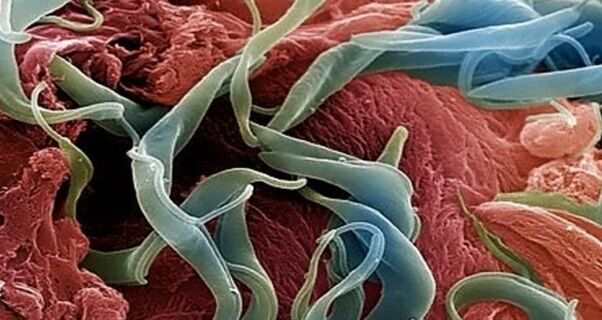
People and animals are attacked by these creatures, the infection is easily transmitted to each other through infected products, water and dirty hands.The appearance of parasites in the body will help prevent the rules of prevention and careful observance of personal hygiene, but even these measures do not guarantee one hundred percent protection.Helminants inhabiting the human body can live in different organs, differ in appearance, size, and the degree of harm caused to human.
Parasites in the human body
How many situations are there when a person has been touring doctors for years and cannot get rid of allergies, cure asthma, drink sugar -naks and all unsuccessful?Each of us has those familiar who have spent huge quantities for the treatment of various diseases and have not received a result.
Only in rare cases where the doctor is either very smart or very responsible, does he direct such a patient to regular stool analysis and then ... Then the parasites are found in the human body, which cause dozens of diseases and with which no one fights in the treatment of these pathologies.
Contrary to the established opinion, the worms are not necessarily "prescribed" in the intestine and can be detected by banal faeces analysis.Many parasites feel great in the lungs, heart, muscles, even in the brain and eyes.
The famous malaria, which has ever been defeated, returned again and this is the most dangerous parasitic disease, according to experts.Malar plasmodium lives exclusively in the blood, and not every doctor will be able to recognize this disease with sufficient confidence.
How parasites fall into the human body
They fall into the human body in different ways, most often it is due to the use of infected water and food.
Grape eggs remain viability for up to 6 months and through toys, carpets, linen and pastel underwear enter the body.Askarid's eggs come to us inside poorly washed vegetables and fruits.Barbecue or pork is a 95% guarantee of trichinosis infection.
The parasites penetrate inside us with insect bites when they bathe in freshwater tanks, through air, with a powder that carries eggs.
Salt fish, stenored or caviar are the cause of straps infection, the length of which reaches 12 meters and which can live in your body under 25.Infection cases have become more common in the parasites in the womb.Dogs and cats through wet breathing can distract the eggs of parasites up to 5 meters.
You can get infected through dirty hands, not only your own, but also sellers, cooks, waiters, parasites, travel with money and railings on public transport.High concentration of parasitic eggs is observed in products such as: bacon, smoked sausage, ham, sausages, pork of all shapes, beef, chicken, lamb and even chicken eggs are often infected with them.
Epidemiologists around the world are trying to fight this misfortune.In the United States, for example, to check helminth, 1 pork meat is destroyed every thousand.This develops in multi -million dollar losses, but otherwise it is impossible.
There are no absolutely reliable ways of disinfection of meat and ordinary culinary processing of larvae does not destroy.You cannot guarantee the cleanliness of your food by welding or frying meat, a huge number of parasite larvae still penetrate your body.
In which organs can live in parasites
The helminth parasites are divided into two categories that correspond to the site of activity in the donor body:
- cramp: Worms living in different gastrointestinal sections.There are about 100 varieties of intestinal parasites, and for each bowel department there are several dozen species.The small intestine is ready to take ascaris, antelity, wide ribbons, and more more commonly found "brothers".The small intestine will "share the living space" with Pinworms, a dwarf chain and the rest.The medical literature describes cases where one person has been infected with several types of parasites at the same time;
- Fabric:The worms are localized in organs, tissues and even in the blood.Modern medicine has successfully dealt with paragonosis (lungs), cysticchosis (brain), echinococcosis (liver) and phylairiosis (lymphatic vessels).Some worms of worms move through the body through the blood system and randomly attach to any organ.If many eggs are introduced, then the whole body can be infected.
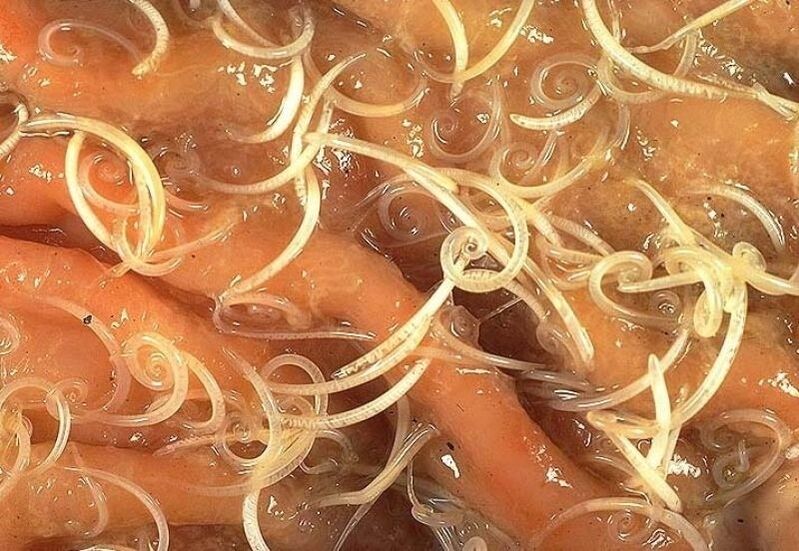
Snoes - What do they look like in the human body (a picture of worms)
Speakers- These are one of the most common human parasites that are a round worm (nematode).Most often, Pinworms infection is found in children, but is also found in adults.
The pin is a white parasite, small and round.The individuals of the female individuals have dimensions: length 8-13 mm, thickness 0.5 mm, oblong shape and straight tail directed at the end.
This characteristic of the tail of the female parasite explains its name - a "cutter" of the word "acute".The male individual is much smaller: its length is 2-5 mm, the thickness is 0.2 mm, the tail is bent, unlike the female pincors.
Human invasion has the name enterobiosis and is mainly found with a mismatch with personal hygiene rules (insufficient hand washing).In general, the Pinari live in the small area of the intestine and upper colon, but in some cases they can migrate to other organs and systems of organs.

The female helminth, after falling into the human body in an oral way and mating with the male representative of nematode, migrates to the thick bowel department, where it receives the necessary nutrients for life and maturing eggs from undigested nutritional residues.
After 4 weeks, the female cutter begins to migrate in the rectum at a speed of 12 cm per hour, crawls from the anus and lays about 5000-15000 eggs in the perianal region, which after 4-6 hours is completely ripe and ready for an additional life cycle.
This process may be accompanied by itching, which encourages the infected person to combine the anus and thus contribute to the more distribution of parasites that fall into food from under the nails, in the hands of other people (especially for children who are very close in contact with each other and do not always monitor personal rules).
Pinworms infection comes from person to person, through the dust with parasitic eggs, objects that the patient touches.Losing eggs can also be transferred to food with cockroaches and flies.
Also, eggs remain on linen, clothes, beds, which explains their rapid distribution.Due to the fact that the life cycle of the worm is very fleeting and the infection comes from person to person, it is quite difficult to get rid of parasites, as in addition to taking antihelmintic drugs, the patient's personal belongings are also needed by his isolation from other nematoded environments.
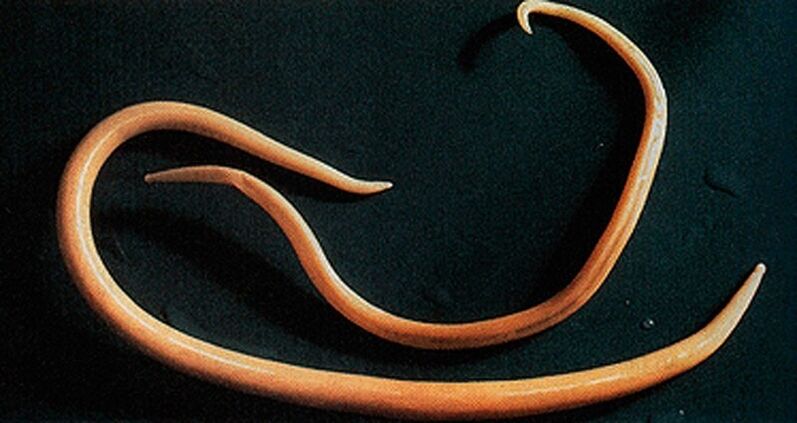
Askarides - What do they look like in the human body (a picture of worms)
Ascarid-This is a large parasite with a red-yellow spindle-shaped spindle, reaching an adult of 40 cm (women) and 15-25 cm (men).Without a suction glass or other fixing devices, Ascaride can independently move to food masses.The eggs laid by the female parasite feature stools.
Akad infection in the case of absorption of ripe eggs together with water or unwashed vegetables and fruits on which there are soil particles.After the eggs penetrate the intestine, ripe larvae come out.
Then, introducing into the intestinal wall, they reach the heart according to the flow of blood and from there they fall into the lungs.Through the pulmonary alveoli, the ascarid larva through the respiratory tract again penetrates the oral cavity.
In the intestinal phase of their existence, the ascarids, endowed with the ability for spiral movements, can penetrate even the narrowest holes.This characteristic of the parasite often leads to the development of quite serious complications (mechanical jaundice or pancreatitis)
After repeated swallowing, the parasite reaches the small intestine where it develops in an adult.The worm lives for 12 months, then dies and stands out with stools.In the gut of an owner, one or several hundred individuals can live.
Ascaris -secreted allergens can cause severe allergic reactions.A large number of adults can cause intestinal obstruction, and the worms that have penetrated the respiratory tract sometimes cause suffocation.

Vlasovs - What do they look like in the human body
BlakoviThey often live in the southern regions because the eggs of this worm love heat.Most infections are observed in rural areas.VLASS -HEAD EGGS live in the soil.
The invasion occurs through the hands, contaminated particles of the ground, poorly washed vegetables and fruits.As a result of infection, a disease occurs - trichocephalosis.Vlasev parasitizes in the intestine.This worm causes anemia as it feeds on human blood and severe abdominal pain.
For the diagnosis of trichocephalosis, the rectum and sigmoid intestine are examined with a special device (rectoscopy).In this way, the accumulation of parasites in the intestine is detected.The treatment of invasion is long as the wounds are protected from a thick sheath.
Parasitic eggs stand out with stools, but they are very small, they cannot always be seen even under a microscope.Only with a very strong invasion is it possible to detect eggs when analyzing the stool.In shape, they look like a barrel, have a brownish-yellow color.
On 2 sides, the eggs are holes.What do the worms look like in the stool?It is very difficult to find them alive in bowel movements, since Blazoles cannot live for a long time outside the human body.Only with antelmintic therapy can be seen in the stools of dead worms of white color.
Liver bacon - what does it look like in the human body
A parasite causing inventory is a flat worm reaching a length of 7-20 mm.
In the acute phase of helminthiasis, the patient has soreness in the upper abdomen, body temperature increases, nausea, muscle pain, diarrhea and skin rashes are possible.The larvae of the parasites begin to develop after the eggs fall into fresh water (the snails swallowed).Then they penetrate the body of the fish (carp, crooked carp, platypus, cockroach).
Human infection occurs when you eat infected fish meat, which has not suffered sufficient heat treatment.The larva of the liver bomb from the small intestine penetrates the bile ducts and into the gallbladder, fixing there with two suction glasses.
The chronic course of opistorchiasis is manifested by symptoms of hepatitis, inflammation of the biliary tract, cholecystitis, impaired digestive tract, nervous disorders, weakness and increased fatigue.The parasite is a pursuit of the development of irreversible changes, and even after its expulsion, the patient does not transmit chronic inflammatory processes and functional disorders.
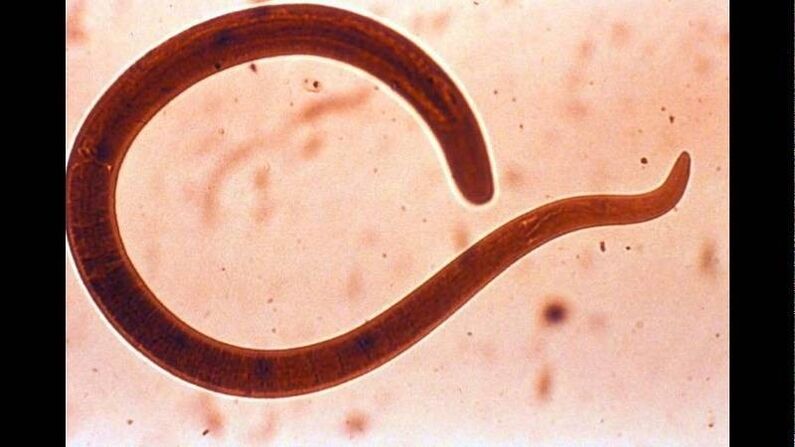
Trichinella - what looks in the human body (a picture of worms)
The causative agent of the trichinosis is a small round helminth that reaches 2-5 mm in length.The infection occurs with the use of poor fried meat (pork, bears, wild boar).By penetrating the intestine, the larva of the parasites for 3-4 days ripen to the condition of the sexually mature individual.
The life expectancy of the worm is 40 days, after which the parasite dies.Driving the intestinal wall, the larvae penetrate into the bloodstream and are carried in all organs of the human body, precipitating in the muscles.In this case, the respiratory and facial muscles, as well as the muscles-to-bangs of the limbs, are most often affected.
In the first days after the invasion, patients complain of abdominal pain.
Then, after about 2 weeks, body temperature rises to 39-40 s, itchy rashes appear on the skin, muscle pain develops and the face swells.
During this period, in the case of a large -scale infection, there is a significant risk of death.After about a month, a recovery occurs.The parasite is spiral encapsulated and then died within two years.
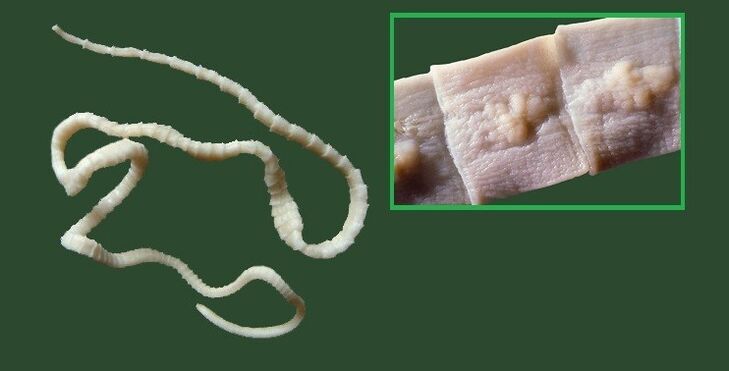
Wide Lart - What does the human body look like
It is one of the largest helminths, reaching a length of 10-20 meters.The disease caused by this parasite is called dipylobotriosis.The cycle of worm development begins with freshwater fish or crustaceans.
Reaching the small intestine, the parasite is attached to its wall and grows to a sexually mature individual for 20-25 days.
The larva enters the human body, which is the final owner of a wide ribbon with caviar or infected fish fillet.
Difibriosis occurs against the background of disorders of the digestive tract and anemia with a deficiency of B12.
Echinococcus - what does a person's body look like
For this parasite, a person is an intermediate host.The worm parasites in the human body in the form of Finnish.The last owner of Echinococcus is a wolf, dog or cat.
The infection is made allying in contact with animals and environmental objects, with a handful of echinococcus eggs.Once they enter the intestine, they develop oncosphere (six larvae) of them.From the intestine they penetrate the bloodstream and carry throughout the body.
The "favorite" places for the parasitisation of the worm are liver and light.Setting up in these organs, the larva becomes a fine (echinococcal cyst), which gradually increases in size, begins to destroy the tissues nearby.
Often echinococcosis in the diagnosis process is misled by a tumor of benign or malignant origin.In addition to mechanical exposure (squeezing of organs and blood vessels), an echinococcal cyst sometimes occurs.This condition can cause a toxic shock or the formation of multiple new cysts.
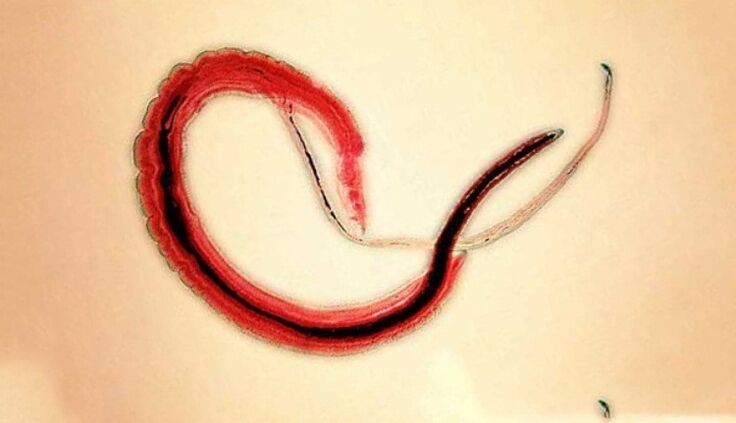
Alveococcus - what does it look like in the human body
This parasite, which is considered a variety of echinococcus, is the cause of one of the most dangerous helminths (alveococcosis), which is similar in severity to cirrhosis and liver cancer.The infection occurs when the oncosphere is penetrated (eggs with ripe larvae) into the intestine.
This parasite, considered a variety of echinococci, is the reason for one of the most dangerous helminths (alveococcosis)
There the embryo comes out of the egg and, introducing into the intestinal walls, penetrates the bloodstream.In addition, with blood flow, the parasite spreads through all tissues and organs of the body (most often localized in the liver).This is where the main stage of the development of the larvae is formed (a multi -bubble balloon, laurelocyst) is formed).
Each camera contains an embryonic parasite head that continues to develop gradually.Lavrocypes are very aggressive entities that are constantly growing due to increasing bubbles and have the ability to germinate in the liver, such as cancer metastases.
Nearby tissues due to impaired blood vessel function are subjected to necrotic changes.Opening structures nearby, Alveokok forms fibrous nodes with the inclusion of multi -bubbles.This condition can last for several years, with regard to which requires compulsory surgery.
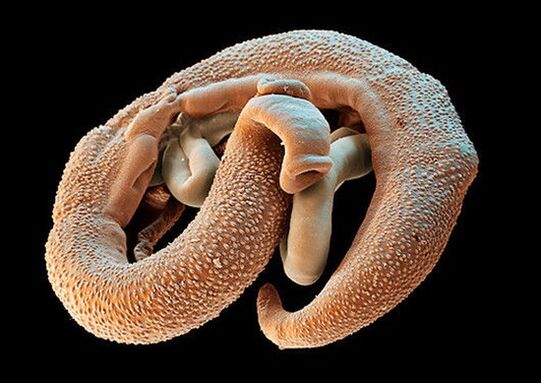
Schistosoma - What does it look like in the human body
Schistosoma - blood -saucer, belongs to the class of trematodes, depending on the type causes different schistosomosis.It is a flat separate helminth, reaching 4-20 millimeters with a length of 0.25 mm wide.The schistosome body is equipped with 2nd suction glasses and the abdomen, they are located close to each other.The female schistos are longer and thinner than men.There is a longitudinal groove on the male body, with it holding the female.Their eggs with a diameter of 0.1 mm, oval shape, on the surface of one of the poles are a large spike.
The human worms of schistosomes in the role of the final owner choose humans, in their organisms they parasitize in small veins of the colon, abdominal cavity, uterus, bladder.The worms feed on blood, partially absorb nutrients through the cuticle.Schistos eggs are transported to the intestine and bladder, where they ripen and stand out with stools or urine.In freshwater, the larva - myuzidium, its intermediate host - molluscs comes out of the eggs.In the body of the molluscs, the metacaria develops until 4-8 weeks.
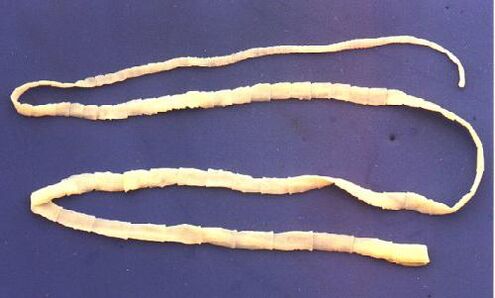
Pork tinge - what does it look like in the human body
Surrey tapeworm, like the bull, there are 4 suction glasses on the body, but in addition to the helminth body is also equipped with a double breakage of hooks.Struril reaches two to three meters in length.The pork tapeworm has three -like ovary, on each side the uterus has 7 to 12 branches.A characteristic feature of this helminth is the ability of the segments to crawl from the anus.After the exterior exterior, their shell becomes dry and explodes so that the helminth eggs enter the external environment.The intermediate master of tapeworm can be pigs and human.
The main owner is a person.The intestinal parasites in humans include pork tapeworm, the helminth is found in the patient's gut, where he lays his eggs.The infection occurs when invasive meat is used.
Which doctor to contact with worms for contact
If a worm infection is suspected, then it is necessary to consult a specialist in medical disease, helminthologist Or parasitologist.You can contact a specialist in infectious diseases in terms of infection with any parasitic worms or protozoa.
Or parasitologist.You can contact a specialist in infectious diseases in terms of infection with any parasitic worms or protozoa.
You can only contact a helminologist if the infection is suspected of parasitic worms (pin worms, ascarides, saliva, optistorchiasis, etc.).
You can contact a parasitologist in cases where the infection of protozoa - lamblia, toxoplasms and amoebas is suspected.
In addition, if the parasite is not located in the lumen of the intestine or stomach, but in other organs (eg the lungs, liver), then you can contact a specialist who deals with the diagnosis and treatment of diseases of the organ.This is, for example, in opistorchiasis, you can also contact a gastroenterologist or hepatologist and echinococcosis to a pulmonologist.


















